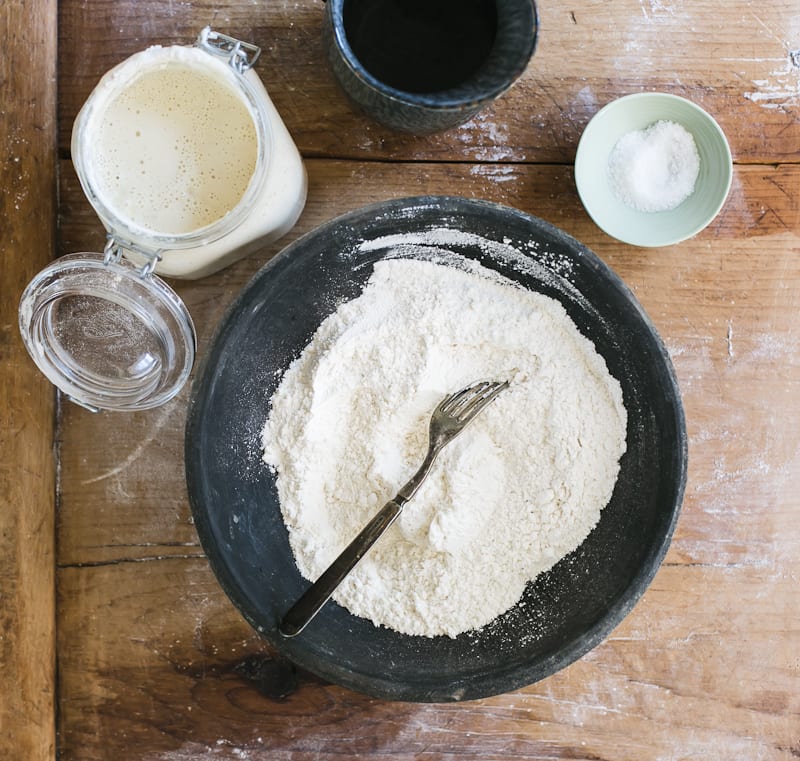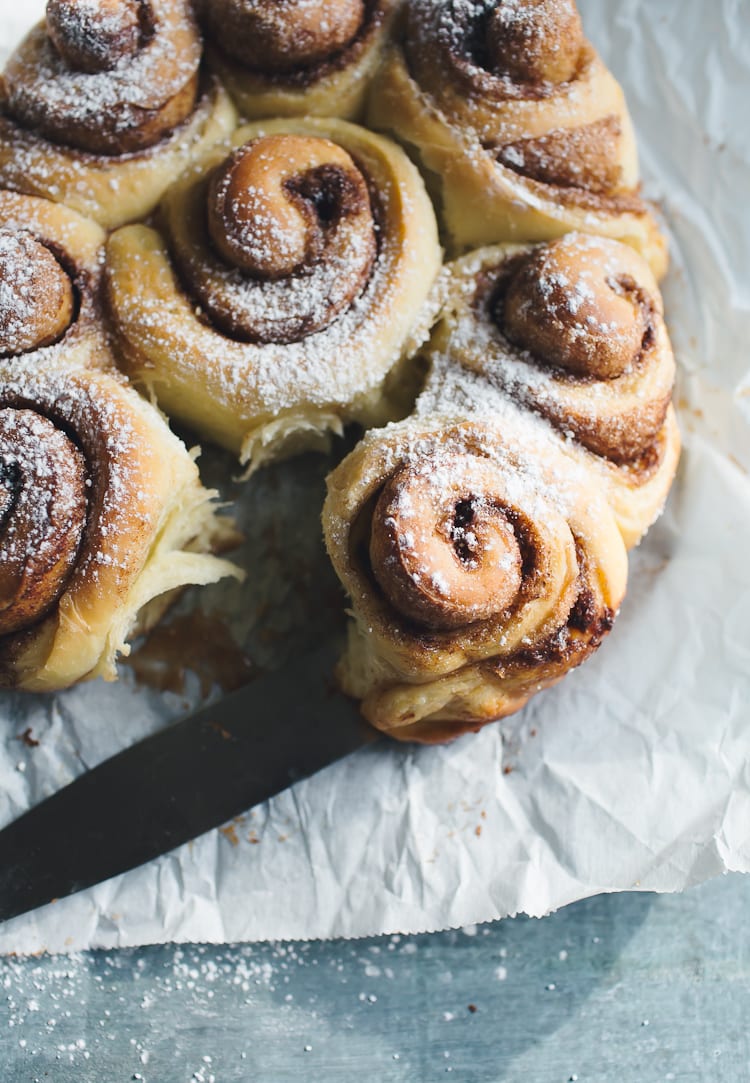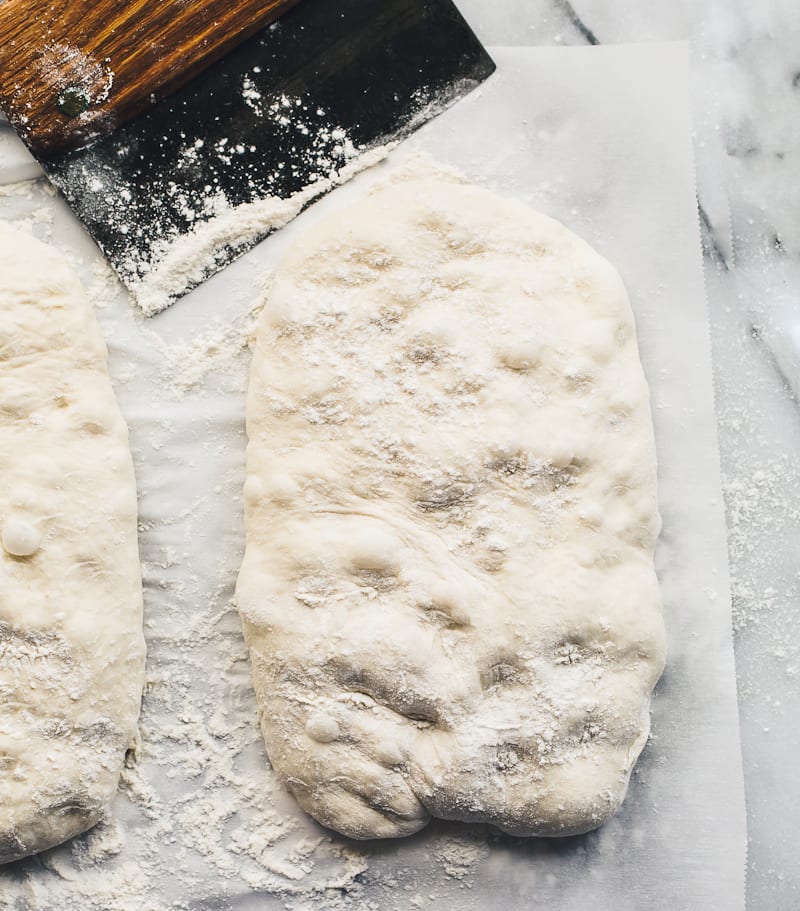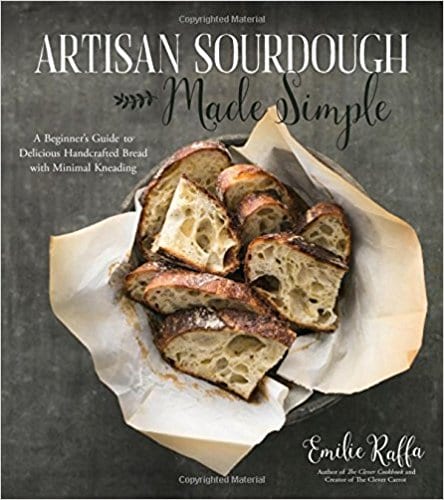While they might look the same, bread flour and all purpose flour are actually quite different. Here’s everything you need to know about choosing the right flour baking.

Shopping for flour can get really confusing. When choosing between bread flour and all purpose flour, is there really a difference in a sourdough bread recipe? Turns out, the answer is yes and it mainly boils down to protein content.
Why Protein Matters
All flour contains protein. The higher the protein, the stronger the flour. Strong flour is preferred by bread bakers for better gluten development and in most cases, a higher rise.
Low protein flours are best for baked goods that do not need a high rise, like cookies and cakes.
Yet ironically, unless you’re a bread baker, no one really talks about protein content. It’s rarely advertised (in percentages) on a bag of flour either. But as you continue to bake, it’s important to understand why protein matters so you can choose the right flour for baking.
What Is Bread Flour?
Bread flour is a high protein flour, usually made from hard wheat varieties. It contains about 12- 13% protein, depending on the brand.
Because it’s a “strong” flour, it’s excellent for chewy bagels, artisan-style sourdough bread and anything else that needs structure and height. It also adds a delightful chewy texture to the finished product.
Bread flour is also a “thirsty” flour, which means it absorbs more water than low protein flour. For example, if your dough feels really dry (especially in winter) and you have to add more water to loosen the texture- that’s why. Same goes for adjusting the texture of your sourdough starter.
BAKER’S TIP: Bread flour is also known as “baker’s flour” in the Australia and “strong flour” in the UK. In France, the bread flour equivalent would be T55 or T65 depending on the style of bread you’re making.
What Is All Purpose Flour?
All purpose flour– which is made from both hard and soft wheat- is best for everyday baking. It’s considered a medium to low protein flour with about 10-11.7% protein, depending on the brand.
All purpose flour is best for muffins, cookies, cakes and other baked goods that do not require a notably chewy texture or high rise.
It’s also not as thirsty as bread flour, which means it will absorb less water.
Can you bake bread with all-purpose flour? Yes! With some adjustments, you can absolutely bake bread with all purpose flour. You’ll get a soft, tender, and in some cases, a fluffier product. I use all purpose flour for my sourdough cinnamon rolls! See additional recipe suggestions below.
Here are 3 sourdough bread recipes that use all purpose flour only:

Can You substitute Bread Flour for All Purpose in Sourdough?
Yes, but it’s not always an even swap.
Flour is a like a sponge. And because all purpose flour absorbs less water than bread flour, you’ll need to reduce the total amount of water in a recipe that specifically calls for bread flour. Otherwise, the dough will be too sticky. I typically recommend reducing it by 15-30 g.
Many beginner bread bakers make this mistake- doing an even swap- and end up with poor results because they just didn’t know.
What’s the Best Flour For Sourdough Bread?
For grocery store brands, King Arthur Bread Flour (12.7% protein) is excellent for sourdough bread. KAF Organic Bread Flour is great too- the texture feels like soft powder. You can also try Bob’s Red Mill Artisan Bread Flour (12.5 – 13.5% protein).

How to Maintain CoNsistency In Bread baking
Because protein content in flour varies across the board, even in different countries, bakers will need to make adjustments to the dough regardless of the recipe.
My Aussie friend Celia, made my sourdough ciabatta from Artisan Sourdough Made Simple.
In a text she said “Emilie! I forgot to reduce the water in your recipe and the dough was like soup!”
Why did this happen?
Australian bread flour is actually lower in protein than US bread flour. And because low protein flours absorb less water than high protein flours, her dough was just too wet (in a recipe that was already wet to begin with!). She needed to add more flour to get the texture right.
Without practice, you’ll never know what the “right” texture actually is. So, look for recipes with visual indicators- what the dough should look and feel like- for reference.
New to sourdough baking? There’s a ton of information out there. Stick with the same brand of flour and the same sourdough bread recipe until you understand how dough works. Too many changes = too many problems. Find a baker that resonates with your style and I guarantee your technique and baker’s intuition will improve.
Bottom Line
While they might look the same, bread flour and all purpose flour are actually quite different, especially in bread baking. Variance in brands, protein content, and overall quality will effect their performance. But now, you can choose the right flour with confidence to bake with success.


Comments
Richard says
to get recommended consistence ,how much water i need for 500 gram of white high glutens’ bread flour
Lisa in Michigan says
Thank you so very much for the following info: “all-purpose flour absorbs less water than bread flour, you’ll need to reduce the total amount of water in a recipe that specifically calls for bread flour. Otherwise, the dough will be too sticky. I typically recommend reducing it by 15-30 g.” Thank you! I couldn’t find this information anywhere! BUT I still have a very important question…. reduce water by 15-30 grams PER CUP of flour used? Thank you so very much in advance!
Emily says
I like bread flour more.
Sue says
I made the high hydration sourdough from your book and the dough didn’t rise as much I would have liked. I used bread flour and followed your directions. What should O do next time?
By the way, I love your book and I’ve recommended it to friends.
jane mucklow says
I am on my third attempt at making a sourdough starter. I wonder if it’s my flour. I’m using organic unbleached all purpose flour from Central Milling Company. It says the protein is 3g for 10lb bag. Everyone I talk to says how easy their starter was. I’m feeling frustrated
Thanks
Susan Dubose says
What a nice article! Thank for sharing!
Jason says
I did got what I need, Thank your so informative and helpful post!
tamilyogi says
Nice Post Sharing
RACHEL GERSON says
Hi Emilie, I started my starter Ruth this fall using your instructions. She’s great! I have now tried many of the recipes in your book and they have all been delicious. My question is regarding the Golden Flax loaf. My dough is always VERY sticky, with little structure. Kind of like an amoeba, it just spreads out. It looks nothing like what your dough looks like in the photos. The bread still tastes good, but it is pretty flat and is starts running off the parchment as I rush to transfer it to the pot for baking. Without the pot, to contain it, it would be a pancake. (It rises and Ruth is always bubbly, but it just is so wet it spreads out.). My mom had a similar problem. Tips? I used ground whole flax flour. I’m wondering if it’s too fine?
RACHEL GERSON says
I mean ground whole spelt flour.
Emilie Raffa says
Fantastic, Rachel! Congrats on your starter!
It could be a few things:
First, if there is too much water in the dough it will naturally be sticky. Always weigh your ingredients, especially the water, for best results.
Additionally, flour is like a sponge. So, the type and brand of flour you’re using might not be able to handle the amount of water in the dough, regardless of ingredient accuracy (does that make sense?). I do not think the ground whole spelt flour is the issue; it’s most likely the brand of ap & bread flour you’re using. The flax seeds make the dough extremely wet too.
Finally, when dough spreads it’s possible it’s over proofed (rose for too long).
Next time, you might want to swap the ap flour for all bread flour, and add the water in increments instead of all at once to form a drier dough. Once the seeds go in, the dough will become wetter. Then, allow the dough to only double in size for the bulk, and shorten the second rise. See how that goes!
Sarah Rivera says
I just got your book & excited to make bread again! Years ago I used a bread machine & would grind wheat berries. I’ve tried working with einkorn wheat bc I heard it was the most ancient & pure. Do you have experience with it & grinding your own? Emmer is another I believe.
Emilie Raffa says
Hi Sarah! It’s funny, because I have a mill but don’t use it often- I end up just buying flour! Need to get back into that ;)
With regards Einkorn and Emmer: they’re both excellent to work with. However, they perform completely different than regular wheat flour. My recommendation is to find recipes that specifically call for these flours, instead of swapping and substituting. You’ll have the best results that way.
Sylviane says
I just checked my big bag of Boreal Organic unbleached white flour from La Milanaise Inc. based in Quebec, Canada and bought at Costco. The protein content is 13.33% (4:30 x 100). So, I’d have to agree with other Canadians that our AP flour is in fact suitable for bread making and comparable to T55 flour. I’d bought bread flour in the past but used AP to make bread when short on bread flour and always wondered what the big deal was as my results did not differ. Now I know why. LOL I wont bother to pay extra for bread flour when good old Canadian AP flour is fine for breadmaking. Thank you for all your shares, I’ve been baking bread for years but now I better understand my successes and failures.
Gilles Caron says
Haha, being from Quebec I also realized that Canadian AP flour was quite high in protein…
No wonder why I was having different results than those using normal AP flour.
I just realized that this week so I will have to remember this for my next bread.
That’s also why my sourdough is very much alive… ;-)
DAWN KLEIN says
Hi, this is MamaDawn, I live at 7500 ft. in Southern Colorado. I just found your article on flour this morning. Flour is CRITICAL for altitude. Because of the lightness of air, a strong flour (protein count of over 11.5) is mandatory. I have written a cookbook that has versions for sea level, 3000-5000 ft, 5000-9500 ft, and 9500 ft and above. It is called Love in Every Bite. It is a complete cookbook with everything from Appetizers to Desserts. My main audience is people transplanting from sea level to altitude. I have been at altitude for 25 years. It is here that I wrote the book. About 5 years ago I realized I had created an entirely new method for baking at altitude that does not use the typical nitpicky changes and experimentation that other high altitude cookbooks use. Oh well. Just found your article interesting. And by the way, I have used a baker’s flour for everything since moving here and professionally baking.
Darren says
This is a great article and valuable transfer of knowledge. I’m not new to working with different flours but you explain flour in a way that stumps me when someone asks me a question about it.
Pauline says
I live in Alberta Canada and Anita’s organic All Purpose Flour is the main flour I use for my bread baking. It’s made from all Canadian organically grown wheat. From what I understand, Canadian wheat is simply higher in protein, therefore higher in gluten. I can buy a “strong” unbleached bakers flour at Costco, “Great Plains”, also Canadian, which is good quality and works well, but I still much prefer to use organic grains in all my baking and cooking. Both AP and the Bakers bread flour have the same protein content, 4g per 30g. You can go to anitasorganic.com to see all their products and process.
When I first started baking the artisan breads, I was concerned I could not find an organic white bread four, but soon realize that using Canadian all purpose flour is the flour to use. I’ve even peaked into some organic bakery’s kitchens here in the Edmonton area, and see they use the same AP flour that I use!
For my fellow Canadians, there are many great Canadian growers and millers around the country. I also love to support local growers for my other flour needs, such as Gold Forest Grains, also in AB, whom I buy most of my other organic flours from, such as Rye, Red Fife and other heritage grains. Another is Highwood Crossing in southern Alberta. There are many…
I have given and recommended your recipe book to many people who enjoy using it as much as I do. Thank you.
Helen says
⭐️⭐️⭐️⭐️Great article.
Dildar says
Thank you so much for this informative article! During the pandemic I also started baking sourdough bread but had trouble finding high protein unbleached white flour. All of the bread flour said bleached, to my amazement! Couldn’t find KF or Bob’s Mill flour around me, so I used Heckers unbleached all purpose flour and General Mills high gluten unbleached whole wheat flour but didn’t state the amount of protein.
Are most bread flours bleached and what could the reason be? By the way I think most commercial bread is made with bleached flour, that was one of the reasons I wanted to make my own bread with less additives.
Sebastian says
Very useful info
Heidi Rees says
I bought your book last winter and have really enjoyed baking from it over the past year! It was definitely a learning curve for me, though, as we had just moved to Austria and the flour here has its own rating system that I did not understand for months. I finally found an Italian bread flour that works like American bread flour (Caputo Manitoba Oro), but had a lot of failures before I found what worked. Austrian all purpose flour comes in different textures as well as in different “ash content” levels, which was horrifically confusing for me. I’ve always added gluten flour to my all purpose flour to make it act more like bread flour when we lived somewhere that I couldn’t get bread flour, and although that does help it still isn’t quite the same – your explanation of adjusting the water called for would definitely make a difference!
Judy Maciejowska says
What an interesting article! I’ve often wondered about the difference in flours. Just yesterday I mixed, what in the the UK we call plain flour with strong flour (I’d run out of strong) to make crumpets. It didn’t make a lot of difference in texture but the absorbancy was affected.
By the way, we don’t call strong flour ‘bakers’ flour’ in the UK – just strong, very strong or, for pasta making ‘OO’ grade. I’d love to know what the difference is with ‘OO’ – maybe it’s an Italian grade?
Carla says
Thank you for this helpful information. I’m new to sourdough and have bought your book. I’ve made several of your bread recipes and they have been coming out great. Thanks for making the recipes easy to understand for a beginner. My family is loving the bread!
John Hadley says
Canadian All Purpose is all mandated (I think) to be 13%. I check the all purpose at the store and it’s labelled here, and all of it is 13.3%.
Emilie Raffa says
John, this is really interesting… What a big difference compared to US flours! Out of curiousity, are you referring to the Robin Hood brand? Im thinking about updating this post to include a chart with flours from around the world.
PS: to all bakers reading this, feel free to chime in with the flour you use, the brand, and protein content!
Sandy says
I’m also in Canada and have two different brands in my cupboard (only because I bought one on sale the other day and the other is almost empty). Walmart Great Value AP and Miller’s Pride AP flour, both 13.3%. I’ve never purchased bread flour before. A few friends were chatting online the other day and one pulled out her Robin Hood bread flour bag, which was labelled as 13.3% as well. 🤷♀️
Beth says
Hi Emilie!
I purchased your sourdough book; I have made several of your bread recipes. Actually I have seeded pumpkin cranberry breading rising as I type this email. I would like to make your toasted sunflower and noticed the recipe calls for some white rye flour. I am having difficulty finding this flour in my area. However I have some dark rye flour. Is it okay to substitute for the white rye?
Emilie Raffa says
Hi Beth! So great to hear :)
Regarding the loaf- I would just replace the light rye with regular bread flour instead. If using the dark rye, the flavor profile/color of the loaf will change a bit. And since I haven’t tested it specifically, I don’t want to throw you off! Enjoy.
Beth says
Thank you for your quick response! I will replace the white rye with bread flour. I am really enjoying your bread book! Some of my favorite – chocolate chip, cinnamon raisin swirl and the flax with spelt! Also the focaccia with pesto and fontina😋
Danny says
I use dark rye, which I source from Flourist Vancouver CA, in all of your recipes and it is spectacular. The toasted sunflower is one of my favorites, I’ve also made bagels with the toasted sunflower flower mix, adjusting the liquid ratio to match the bagel dough recipe, also over the top, as with all of your recipes.